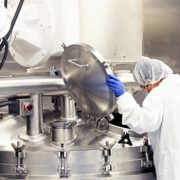Duplex stainless steel refers to the stainless steel that have each 50% of ferrite and austenite , the general content of the less phase is at least 30%, it has both the characteristics of austenite and ferrite stainless steel. Compared with ferrite, it has higher plasticity, toughness, no room temperature brittleness, intergranular corrosion resistance and welding performance are significantly improved, also maintain the 475℃ brittleness of ferrite stainless steel and high thermal conductivity, superplasticity and other characteristics. Compared with austenitic stainless steels, dual-phase stainless steels have higher strength and higher resistance to intergranular corrosion and chloride stress corrosion. Duplex stainless steel is widely used in various applications because of its excellent comprehensive mechanical properties and resistance to chloride stress corrosion, papermaking industry, Chemical and petrochemical industries, Hydrometallurgy; Marine and coastal applications, plumbing installations for food and beverage plants, buildings, etc
Pulp and paper
Beginning in 1930, one of the first applications of duplex stainless steel was in the sulfite paper industry. Today, duplex stainless steel is used in the pulp and paper industry as bleaching equipment, digesters, chip storage tanks, black and white storage tanks, and suction roll housings. duplex stainless steels have high strength, excellent corrosion resistance, and the same pressure rating that allows for the use of thinner sheets, and have now replaced austenitic stainless steels and carbon steels in paper industry applications. It has lower composite material costs, shorter welding times, and lower transportation and handling costs.
Desalination
Due to the high chloride content, high-temperature corrosive process environment, seawater desalination subjected the material to one of the most stringent tests. Desalination customers need to strike a balance between meeting corrosion resistance requirements and keeping their investments affordable. In earlier desalination projects, the evaporators for the MSF and MED desalination plants were manufactured using carbon steel. Later, MSF evaporators are generally coated with 316L austenitic stainless steel. The MED evaporator is first coated with epoxy resin and then stainless steel.
The benefits of duplex stainless steel have high strength (twice that of conventional austenitic stainless steel) combined with high corrosion resistance. As a result, duplex stainless steel evaporators can be manufactured from thinner steel plates, requiring less material and welding. Other benefits include ease of handling and less overall impact on the environment. 2205 duplex stainless steel is used to manufacture bulk duplex steel evaporators. The Melittah MSF facility and the Zuara Med facility in Libya were installed to construct three sets of multistage flash MSF units using the concept of combining two duplex steel, 2205 and UNS S32101.
Oil and gas
In the oil and gas industry, duplex stainless steels play a vital role in helping to withstand harsh conditions. This is because its strength, pitting resistance and crevice corrosion resistance are better than standard austenitic stainless steels, and the pitting value (PREN) of dual-phase stainless steels is usually higher than 40. Duplex stainless steel is mainly used in fluid piping, process piping systems and equipment such as separators, scrubbing units and pumps. At sea area, these materials are used in downhole production pipes, fittings and assembly lines, production tree parts, fluid pipes and pipelines for transporting corrosive oil and gas. Super Duplex Stainless Steel (25% Cr) has high strength, excellent fatigue resistance and good coupling compatibility with other high alloy stainless steels.
Food and Beverages
Economic duplex steels have also proved their value in the food and beverage industry. The material is used in two projects in Spain, a food storage facility and a wine storage facility.
At the Port of Barcelona, Emypro SA built all the food storage tanks using S32101, replacing the EN304/304L. The wine storage warehouse for Garcia Carrion, built by Spanish tank manufacturer Martinez Sole in Demiere, southern Spain, was the first to use dual-phase stainless steel: The S32101 and 2304, as low-cost replacements for 304/316L, were used to build the roof and topmost roof for all new tanks.
Construction industry
Duplex steel plays an important role in the construction of Bridges that need high bearing strength when used in a corrosive and salt environment. The 2205 duplex stainless steel is used for the Stonecutters Bridge in Hong Kong and the Double Helix Walking Bridge in Singapore. In 2006, 2,000 tons of 2205 duplex steel sheets and pipes were used for the Stonecutters Island Bridge. The surface part of the bridge was constructed from custom-sized sheets by Chinese duplex stainless steel manufacturers. These stainless steel sheets are polished and shot-peened for optimum reflectance both day and night.
The world’s largest stainless steel roof at the new Doha International Airport in Qatar is constructed using an economical duplex stainless steel (S32003) containing molybdenum. The terminal’s most prominent feature is its wavy roof, which is said to be the largest stainless steel roof in the world. The roof covers about 195,000 square meters (2.1 million square feet) and uses about 1,600 tons (3.5 million pounds) of dual-phase stainless steel. Several factors must be considered in the choice of stainless steel grades, the most important of which is the distance between the airport and the sea. Not only must the roof resist the heat and humidity of the Middle East, but it must also withstand salt. Other factors for choosing Duplex Stainless steel include cost and a good strength-to-weight ratio when compared to other steels.



